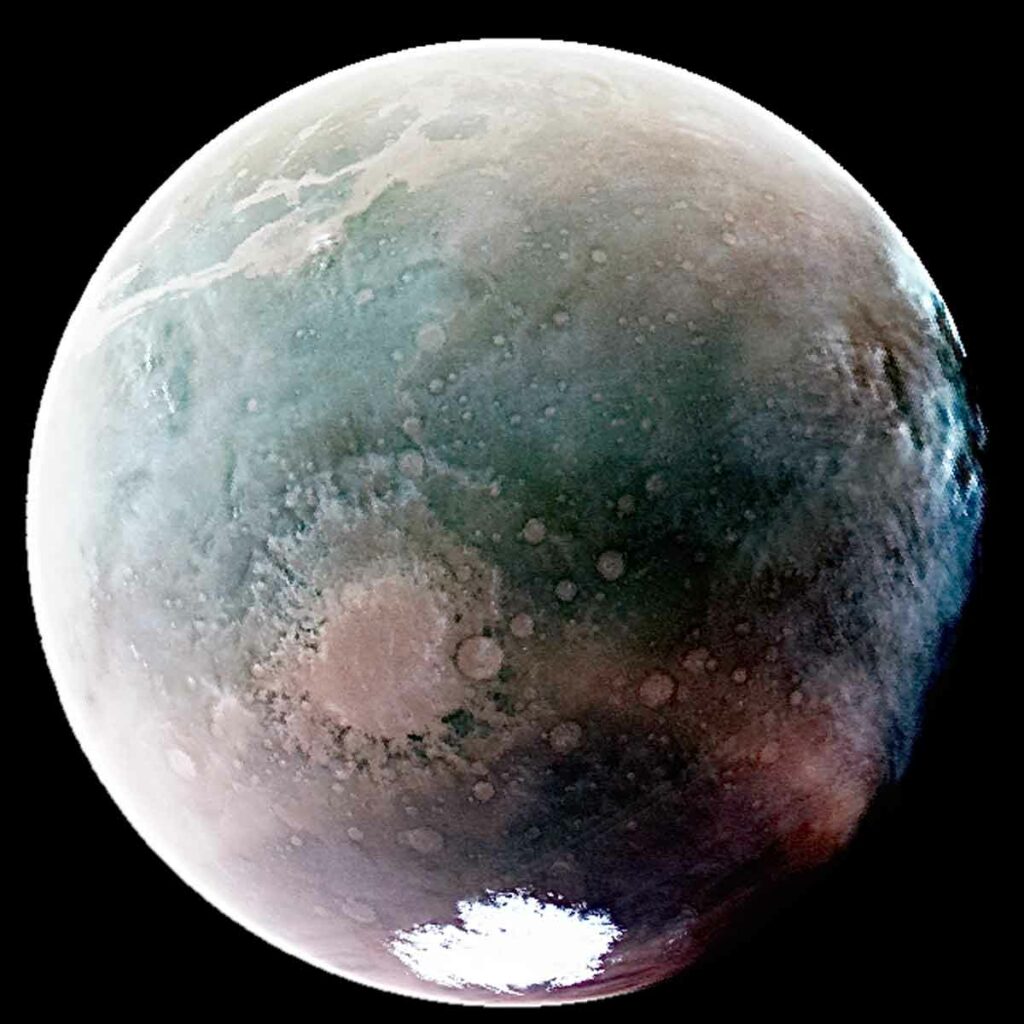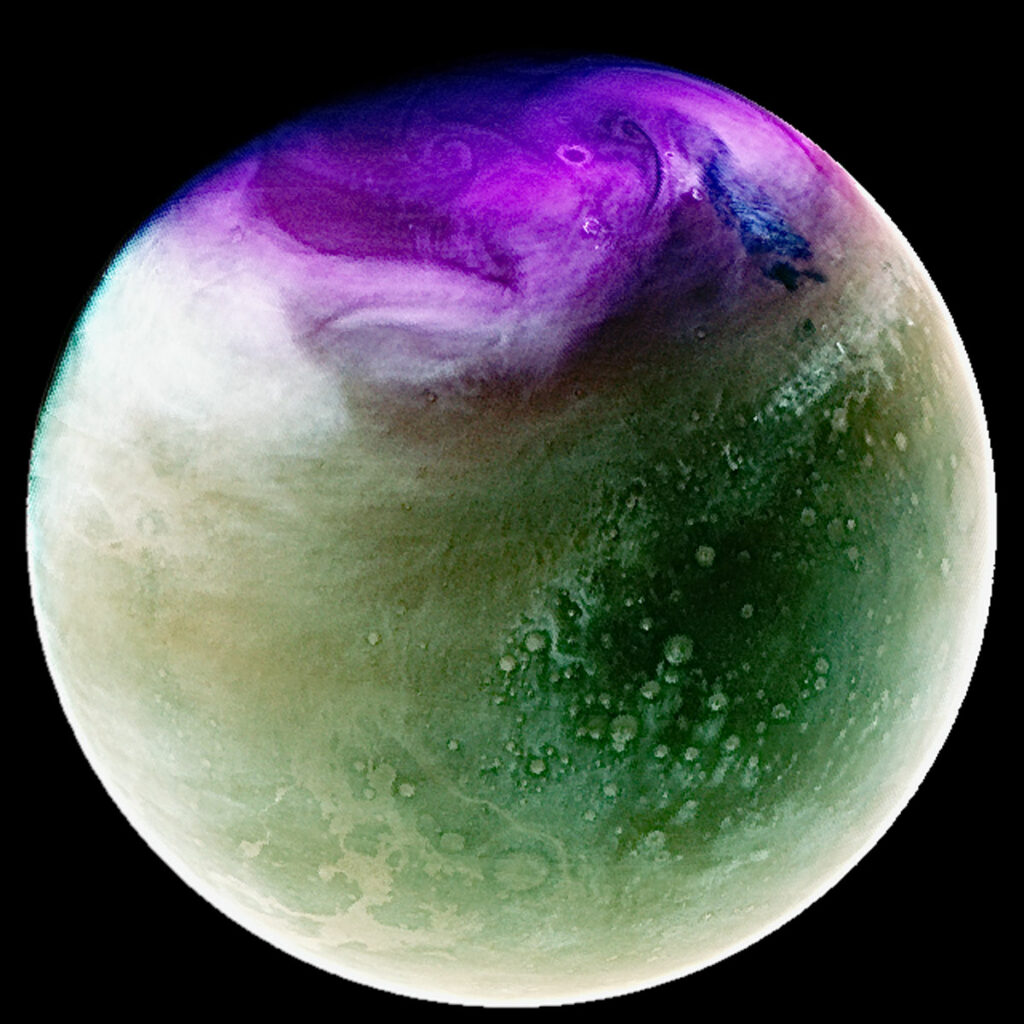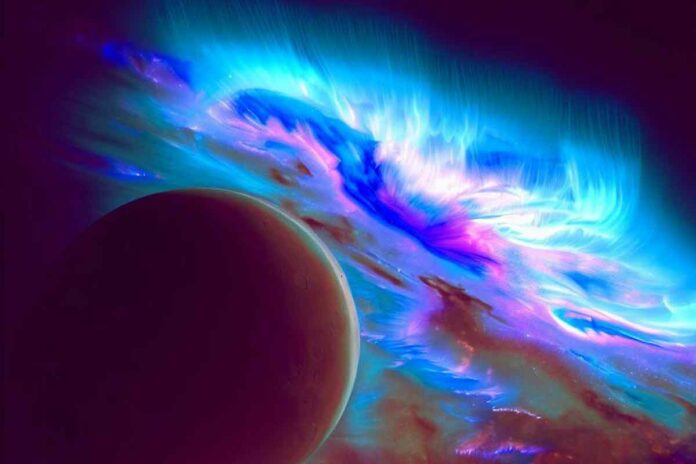In a remarkable display of the Martian atmosphere and surface features, NASA’s MAVEN (Mars Atmosphere and Volatile EvolutioN) mission has unveiled stunning ultraviolet images of Mars.
These captivating visuals were captured at different points along the planet’s elliptical orbit around the Sun, providing scientists with valuable insights into the Martian atmosphere.
The images were taken by MAVEN’s Imaging Ultraviolet Spectrograph (IUVS) instrument during two separate occasions in 2022 and 2023, when Mars was situated near opposite ends of its orbit.
By observing the planet in ultraviolet wavelengths ranging from 110 to 340 nanometers, scientists can study atmospheric components and surface characteristics in extraordinary detail.
To make the ultraviolet wavelengths visible and easier to interpret, the images are enhanced using a color scheme that assigns red, green, and blue to represent the varying brightness levels of three ultraviolet wavelength ranges.
Within this scheme, atmospheric ozone appears as a striking purple hue, while clouds and hazes manifest as either white or blue.
The planet’s surface can take on shades of tan or green, depending on the optimization of image contrast to reveal intricate details.

The first image, taken in July 2022, portrays the southern hemisphere of Mars during its summer season.
This seasonal occurrence is due to the tilt of the planet’s rotational axis, much like Earth’s seasons.
The image showcases the Argyre Basin, one of Mars’ deepest craters, located at the bottom left, enveloped in a pale pink atmospheric haze.
At the top left, the deep canyons of Valles Marineris are visible, adorned with clouds depicted in a tan color.
The white region at the bottom represents the southern polar ice cap, which diminishes during the relative warmth of summer.
During this period, the combination of southern summer warming and dust storms propels water vapor to great altitudes, ultimately leading to MAVEN’s discovery of increased hydrogen loss from Mars.

Moving to the second image captured in January 2023, we observe the northern hemisphere of Mars after it had reached the farthest point in its orbit from the Sun.
The swiftly changing seasons in the north polar region contribute to an abundance of white clouds.
Similar to the previous image, Valles Marineris reveals itself, this time in a tan shade at the lower left, accompanied by numerous craters.
The UV view highlights ozone, which appears as a vibrant magenta color.
During the northern winter’s frigid polar nights, ozone accumulates, only to be diminished during northern spring through chemical reactions with water vapor, limited to lower altitudes in the atmosphere at this time of year.
MAVEN, launched in November 2013 and inserted into Mars’ orbit in September 2014, seeks to explore the planet’s upper atmosphere, ionosphere, and its interaction with the Sun and solar wind.
By unraveling the mystery of atmospheric loss, MAVEN aids scientists in understanding Mars’ atmospheric history, climate, the existence of liquid water, and the potential for planetary habitability.
As the spacecraft gears up to commemorate its remarkable 10th year at Mars in September 2024, the MAVEN team, led by the principal investigator from the University of California, Berkeley, continues to uncover new revelations.
Unlocking Mars’ Secrets
NASA’s MAVEN (Mars Atmosphere and Volatile EvolutioN) mission has recently dazzled the scientific community with a series of ultraviolet images that provide unprecedented views of the Martian atmosphere and surface.
By leveraging its Imaging Ultraviolet Spectrograph (IUVS) instrument, MAVEN captured these captivating images during two distinct periods, shedding light on different aspects of the Red Planet’s mysteries.
Delving into the Ultraviolet Spectrum
The IUVS instrument, operating beyond the visible spectrum, measures wavelengths ranging from 110 to 340 nanometers.
These wavelengths are essential in revealing hidden details of Mars that are invisible to the naked eye.
To enhance the interpretation of these wavelengths, scientists utilize a color representation system where three ultraviolet wavelength ranges are assigned varying levels of brightness, represented as red, green, and blue.
A Tale of Two Images
The first image, taken in July 2022, unveiled the splendor of Mars’ southern hemisphere during its summer season.
At the forefront, the Argyre Basin, a profound Martian crater, was revealed, adorned with a delicate pale pink atmospheric haze.
Towering above, the deep canyons of Valles Marineris exhibited majestic cloud formations, creating a striking contrast against the tan-colored landscape.
The southern polar ice cap, a prominent feature during the summer, shimmered in brilliant white, signaling its retreat due to the seasonal warmth.
This period also witnessed MAVEN’s groundbreaking discovery of heightened hydrogen loss, attributed to the interplay between southern summer warming, dust storms, and water vapor.
The second image, captured in January 2023, shifted the spotlight to Mars’ northern hemisphere.
Here, the planet showcased a mesmerizing display of white clouds, a consequence of the rapidly changing seasons in the north polar region.
Valles Marineris once again took center stage, revealing its intricate beauty in shades of tan.
Standing out amidst the clouds, the magenta hue of ozone added a touch of mystery to the composition.
Ozone accumulation during the frigid polar nights of the northern winter and subsequent chemical reactions with water vapor in the spring unveiled the planet’s complex atmospheric dynamics.
MAVEN’s Extraordinary Journey
Having embarked on its interplanetary voyage in November 2013, MAVEN successfully entered Mars’ orbit in September 2014.
Since then, it has diligently pursued its mission to explore the planet’s upper atmosphere, ionosphere, and interactions with the Sun and solar wind.
By unraveling the enigma of atmospheric loss, MAVEN provides scientists with valuable insights into Mars’ ancient atmosphere, climate patterns, the presence of liquid water, and the potential for sustaining life.
As the spacecraft prepares to celebrate its remarkable 10th anniversary at Mars in September 2024, the MAVEN team, comprising researchers from the University of California, Berkeley, and managed by NASA’s Goddard Space Flight Center, remains committed to unraveling the secrets of the Red Planet.
Conclusion
NASA’s MAVEN mission has once again demonstrated the marvels of space exploration by capturing breathtaking ultraviolet images of Mars.
These visuals offer unparalleled insights into the planet’s atmospheric composition and surface characteristics.
As scientists continue to analyze and interpret these remarkable images, the mysteries surrounding Mars are gradually unraveling, paving the way for a deeper understanding of our neighboring planet’s past and potential for future exploration.
FAQ
The MAVEN (Mars Atmosphere and Volatile EvolutioN) mission is a NASA initiative launched in November 2013 with the primary objective of exploring Mars’ upper atmosphere, ionosphere, and their interactions with the Sun and solar wind. It aims to unravel the mysteries surrounding the loss of Mars’ atmosphere and provide insights into the planet’s atmospheric history, climate, liquid water, and potential for habitability.
The ultraviolet images of Mars were obtained using MAVEN’s Imaging Ultraviolet Spectrograph (IUVS) instrument. This instrument operates beyond the visible spectrum and measures wavelengths ranging from 110 to 340 nanometers. By rendering these wavelengths visible through a color representation system, scientists can study the Martian atmosphere and surface features with greater detail.
In the ultraviolet images, the colors represent varying brightness levels of three ultraviolet wavelength ranges. Red, green, and blue are used to depict these brightness levels. Atmospheric ozone appears as a vivid purple color, while clouds and hazes are represented in shades of white or blue. The surface of Mars can appear tan or green, depending on the contrast optimization used to enhance details.
The first image taken in July 2022 showcased Mars’ southern hemisphere during its summer season. It featured the Argyre Basin, one of the planet’s deepest craters, filled with a pale pink atmospheric haze. The image also captured the majestic cloud formations in the deep canyons of Valles Marineris, depicted in a tan color. The southern polar ice cap, which diminishes during summer, appeared in brilliant white. This image provided insights into seasonal changes and the loss of hydrogen from Mars’ atmosphere during southern summer.
The second image taken in January 2023 displayed Mars’ northern hemisphere after it had reached the farthest point in its orbit from the Sun. The image highlighted an abundance of white clouds, indicative of the swiftly changing seasons in the north polar region. Valles Marineris, again visible in tan, showcased its intricate beauty. Additionally, the image depicted the magenta color of ozone, which accumulates during the northern winter and undergoes chemical reactions with water vapor in the spring.
The MAVEN mission contributes significantly to our understanding of Mars’ atmosphere and its evolution. By studying atmospheric loss and its impact on the planet’s climate, history, and potential for sustaining life, MAVEN helps scientists piece together the puzzle of Mars’ past and present. The mission’s findings shed light on the planet’s habitability and provide crucial information for future exploration endeavors.
The MAVEN mission involves various institutions and organizations. The principal investigator is based at the University of California, Berkeley. NASA’s Goddard Space Flight Center in Greenbelt, Maryland, manages the mission. Lockheed Martin Space built the spacecraft and is responsible for mission operations. NASA’s Jet Propulsion Laboratory in Southern California provides navigation and Deep Space Network support. The Laboratory for Atmospheric and Space Physics at the University of Colorado Boulder is responsible for managing science operations, as well as public outreach and communications.

